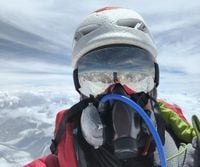In the rugged wilderness of northern Pakistan, the summer of 2025 has become one for the record books—both for breathtaking triumphs and sobering tragedies. As climbers from across the globe converged on the Karakoram and its legendary peaks, a series of daring ascents and harrowing incidents have cast a spotlight on the perilous allure of these mountains, the resilience of those who scale them, and the communities that support this high-altitude theater.
On August 11, the Indonesian Trango Tower Red and White Expedition Team (EMPTT) 2025 etched their names into mountaineering history by becoming the first Asian team to summit the Nameless Tower, a 6,251-meter spire in the Trango Towers complex, via the notorious Eternal Flame route. According to TEMPO.CO, this route is widely regarded as one of the most technically demanding big wall climbs in the world—so much so that, until now, only a handful of elite climbers from Europe and America had completed it.
The six-member team, representing the Big Wall Expedition (IBEX), spent 28 grueling days on the mountain, from July 18 to August 15. Their journey was marked by daunting logistical challenges: they hauled 300 kilograms of supplies up from 4,200 to 5,200 meters above sea level, navigating rocky, treacherous terrain and braving heavy rains that forced repeated delays. As Freden Sembiring, IBEX Chairman and leader of the expedition, described, "It involved moving logistics of about 300 kg, shifted by six people from the main base camp to the climbing base camp, with an elevation movement from 4200 masl to 5200 masl, over rocky and very steep terrain."
But it wasn’t just the elements that tested their mettle. During the ascent, team member Nazib Fadlulah was struck by falling rocks, prompting a complex vertical rescue operation more than 500 meters above the base of the cliff. The team halted their climb for two days to stabilize Nazib and evacuate him to Skardu for medical treatment, underscoring the ever-present danger that shadows even the most prepared climbers.
With supplies dwindling and the team diminished, Sembiring, Ikbal K. Fasya, and Deden Wahyudin pressed on, ultimately reaching the summit on August 11—just in time to raise Indonesia’s red and white flag at the dawn of the country’s 80th Independence Day celebrations. The achievement resonated deeply both at home and in the wider climbing community, a testament to perseverance in the face of adversity.
Meanwhile, on the world’s second highest peak, K2, the drama was no less intense. French climber Serge Hardy, initially rumored to have aborted his summit bid, instead pressed on, reaching the top alone on August 12, as reported by ExplorersWeb. Hardy’s ascent was marked by a mix of solitude, ingenuity, and a little luck: after crows destroyed his tent and sleeping bag at Camp 2, he relied on the generosity of the Madison Mountaineering staff for shelter. He waited out the crowds at Camp 3, then launched his summit push under a clear sky, drawing on a single bottle of supplementary oxygen from the infamous Bottleneck onward. "Even at the lowest flow, I suddenly transformed into Superman, trotting through the Bottleneck," Hardy quipped, though he quickly admitted he was exaggerating.
Hardy’s account paints a picture of the social dynamics on K2 this season. As he described, information was scarce and the atmosphere tense, with commercial teams and independent climbers eyeing each other warily. He likened the scene to a spy movie: "Will they go? Will they not?" The secrecy extended to summit plans and even to sharing weather forecasts or rope-carrying duties. Hardy referenced Imagine Nepal’s Mingma G, who had previously criticized independent climbers as "parasites" for using ropes fixed by others, though Hardy pointed out that the so-called "parasites" had offered to help with rope-carrying and weather data, only to be rebuffed.
The summit, however, was not the end of the ordeal. Hardy’s descent was fraught with danger—he described it as "really scary" and suffered slight injuries. He was not alone in this: while summit photos and celebratory messages flooded social media, reports of the treacherous descent were notably absent from most climbers who reached the top on August 11. Lenka Polackova, who summited without oxygen, offered a candid reflection: "While everyone is celebrating the summit, we are celebrating the return…I have never been more grateful for it. The mountain did not make it easy for us until the last moment."
Tragedy struck on K2 as well. Chinese climber Guan Jing, 37, was killed by falling rocks below Camp 1 during her descent on August 12. According to AP, her body was recovered and held at the Combined Military Hospital in Skardu, with Pakistani authorities in contact with Chinese officials in Islamabad regarding next steps. The incident also resulted in injury to a rescuer assigned to retrieve her body, though he was safely helped down the mountain and is now out of danger.
Guan’s death is a sobering reminder of the ever-present hazards in these mountains. It came just weeks after German mountaineer and Olympic gold medalist Laura Dahlmeier died while attempting Laila Peak in the Karakoram. Accidents, often triggered by avalanches or sudden weather changes, are sadly common in northern Pakistan’s high peaks. As Faizullah Faraq, spokesman for the government of Gilgit-Baltistan, told AP, "Climbers are well aware of the harsh weather and all the other risks and challenges. Despite that, they willingly accept these challenges and come here to attempt these summits."
Despite the string of recent fatalities, Pakistan has not issued any warnings or restrictions for mountaineering expeditions in the region as of August 17. Instead, authorities say they are working to improve infrastructure, rescue facilities, and security for visiting climbers. The stakes are high: from May to September each year, hundreds of climbers flock to the Karakoram and Himalaya, bringing millions of dollars in direct revenue and providing seasonal employment for local communities. As Faraq explained, "A large number of people work on these expeditions from May to September, feeding their families for the whole year with these earnings."
This year, the challenges have been compounded by higher-than-normal monsoon rains, which have triggered flash floods and landslides across Gilgit-Baltistan. These environmental hazards add yet another layer of risk for climbers and rescue teams alike.
By mid-August, Base Camp on K2 stood empty, the last of the season’s climbers having departed. For some, the mountains delivered glory; for others, heartbreak. But for all who ventured onto these storied peaks, the summer of 2025 will be remembered as a season when the line between triumph and tragedy was as thin as the air above 8,000 meters.





